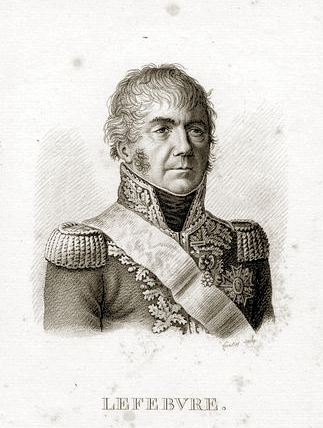Francois Joseph Lefebvre
(1755-1820)
Francois Joseph Lefebvre, Duke of Danzig, 1755-1820, was one of Napoleon’s more experienced marshals, rising to the rank of general of division during the revolutionary wars. Despite this he rarely held an independent command and did not take command of a large battle until Zornoza in 1808.
Lefebvre was already a sergeant in the Gardes Francaises at the time of the revolution. He was a support of the revolution, and soon received a commission. He fought in most major revolutionary battles from Fleurus to Stokach, where he was badly wounded. During this period he rose through the ranks, reaching general of division.
His wound forced him to return to France, where he gave valuable assistance to Napoleon during the coup of 18 Brumaire. His rise continues under Napoleon, and he was created a Marshal on 19 May 1804, at the creation of the Empire.
Marshal Lefebvre took part in the 1806 campaign against Prussia, commanding the infantry of the Guard at Jena (14 October 1806). He took command of the French siege of Danzig (March-May 1807), receiving the title Duke of Danzig for his success in that siege.
1808 saw the start of the Spanish uprising and the Peninsular War. The first French invasion of Spain had ended in defeat, and Napoleon was forced to intervene in person. He planned a massive campaign that would destroy the Spanish armies in north eastern Spain. Those armies were rather poorly located. General Blake had one army close to the north coast, while General Castaños was further south east, in the Ebro valley. Napoleon decided to launch a massive offensive through the gap between these armies, heading for Burgo. Once through the gap the French would sweep left and right, isolating and destroying both French armies.
If this plan were to succeed then the Spanish armies had to remain as close to the French starting line as possible. Accordingly Napoleon ordered his marshals not to take any offensive operations. Lefebvre was ordered to take IV Corps and take up a position in front of Blake’s army between Durango and Zornoza.
Once there Lefebvre found himself facing a Spanish army that was both smaller and of lower quality than his own. On 29 October 1808 at Zornoza, claiming that his outposts had been attacked, Lefebvre took the chance to take command of a large battle for the first time and launched an attack on the Spanish position. The French attack soon broke into the Spanish centre, and Blake was forced to retreat towards Bilbao. Although Lefebvre had indeed won his battle, his action had made Napoleon’s task somewhat more difficult.
Although Lefebvre had acted without orders, he remained in favour. At the end of 1808 he was appointed to command the Bavarian contingent (VII Corps) for the Eggmuhl campaign. In this role he fought at Abensberg (20 April 1809) and Eggmuhl (21-22 April 1809). During the Russian campaign of 1812 he commanded the Imperial Guard. He also fought with skill in the final campaign in France in 1814.
After the first Bourbon restoration Lefebvre was made a Peer of France, but this did not stop him from returning to Napoleon’s side during the 100 days. His punishment after the second Bourbon restoration was mild – he was not allowed to take his seat as a Peer until 1819. He died in Paris on 14 September 1820. Marshal Lefebvre had been a trustworthy and brave subordinate but had not performed so well when given an independent role.
Rickard, J (30 January 2008), Marshal Francois Joseph Lefebvre, duke of Danzig, 1755-1820 , http://www.historyofwar.org/articles/people_lefebvre_marshal.html

